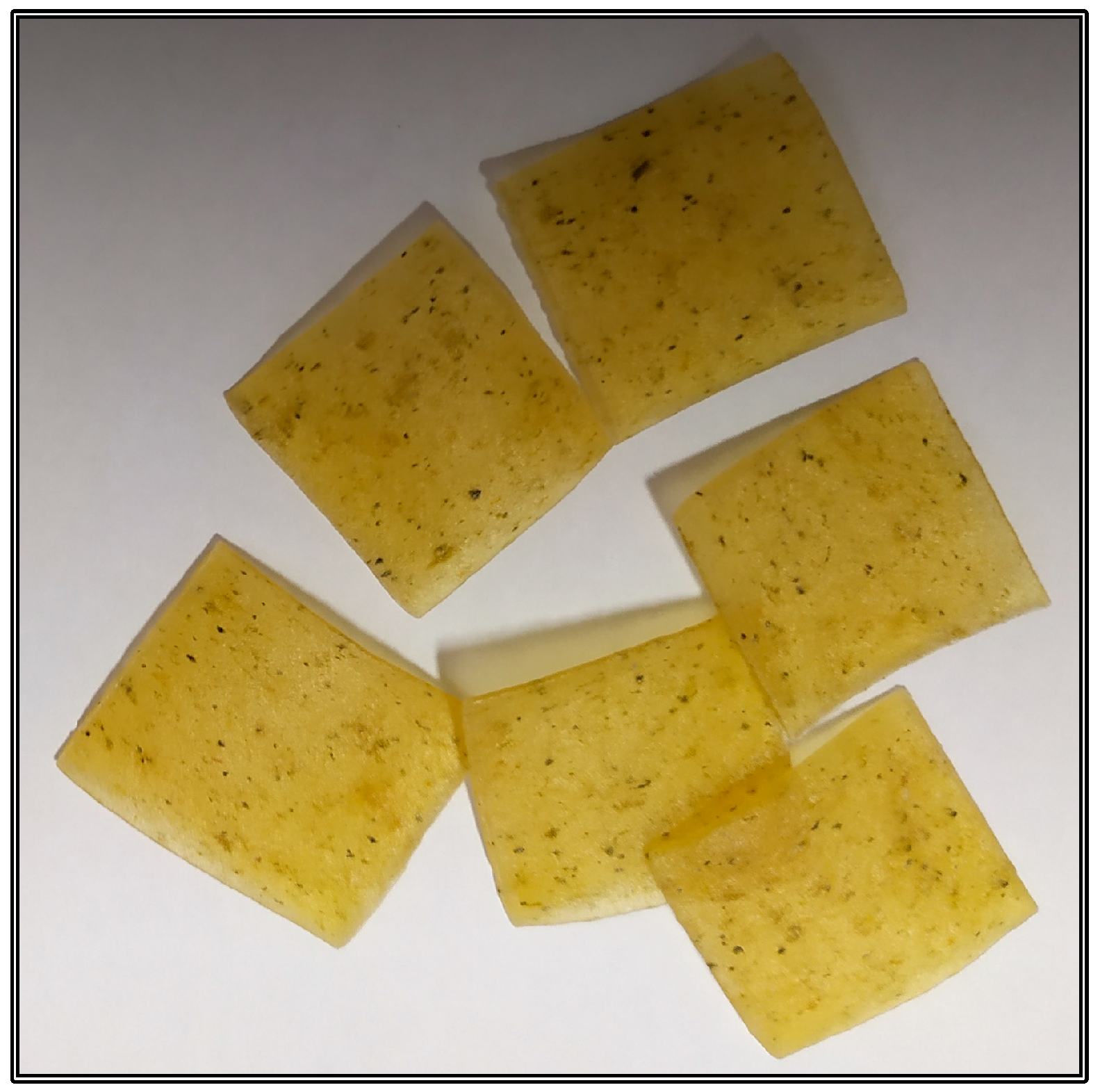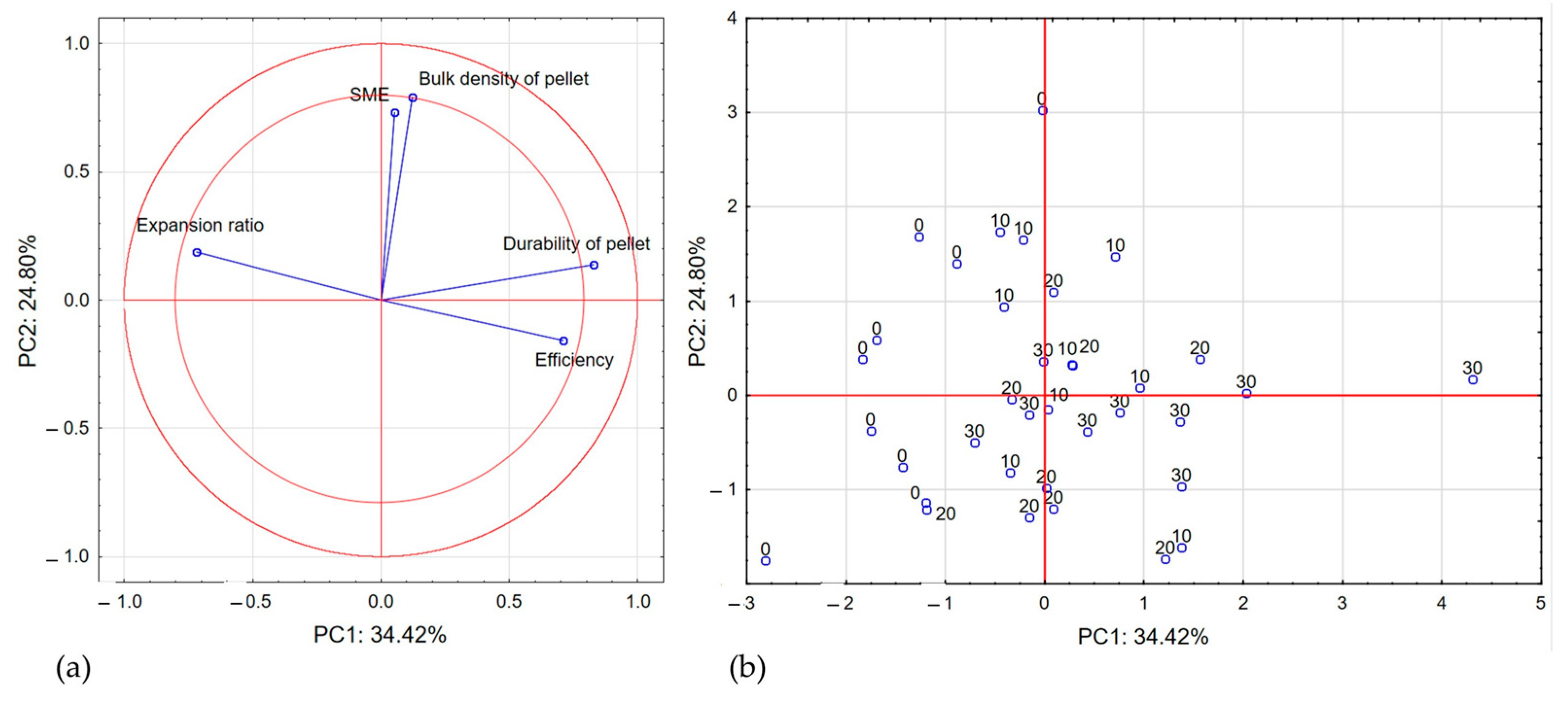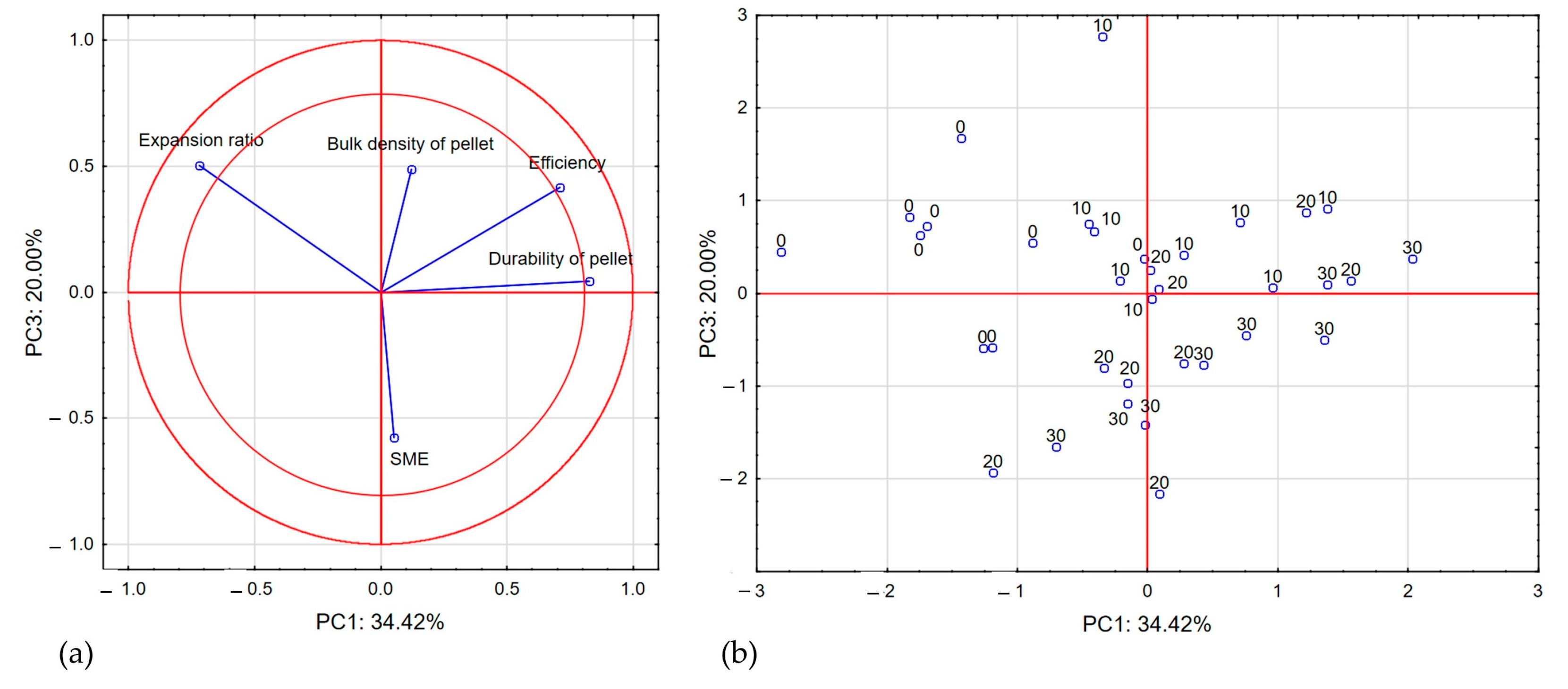Fresh Broccoli in Fortified Snack Pellets: Extrusion-Cooking Aspects and Physical Characteristics
Abstract
1. Introduction
2. Materials and Methods
2.1. Materials
2.2. Extrusion-Cooking of Snack Pellets
2.3. Extrusion-Cooking Process Efficiency and Energy Consumption
2.4. Quality of Pellets and Snacks
2.5. Statistical analysis
3. Results and Discussion
3.1. Effect of Variables on the Processing of Snack Pellets
3.2. Effect of Variables on Selected Physical Properties of Snack Pellets
4. Conclusions
- Higher extrusion-cooking process efficiency was observed for all raw material mixtures with the fresh broccoli addition. The control samples without the addition of fresh broccoli, processed at the lowest extruder screw speed and at the highest moisture level, showed the lowest process efficiency values;
- The addition of fresh broccoli to the potato-based snack pellets processed by extrusion-cooking resulted in relatively low energy consumption. The energy consumption of the extrusion-cooking process for the new generation of fortified snack pellets was influenced differently by the screw speed and moisture level. During the extrusion of mixtures with 20% fresh broccoli content, we observed an increase in SME value along with an increase in the moisture level of the raw material mixtures. The extrusion of pellets with 30% fresh broccoli was characterized by stable energy consumption during processing;
- In general, the increasing amount of fresh broccoli added to the processed mixtures reduces the value of the expansion index of the obtained snack pellets. We noted higher values of the expansion index as the screw speed and moisture level increased;
- The extruded blend moisture content and the extruder screw speed had a significant impact on the bulk density values. Snack pellets with the addition of fresh broccoli showed reduced bulk density values;
- We noted that the addition of fresh broccoli alone had an impact on the durability of snack pellets. Such an addition allowed for lower values of the tested feature;
- Summarizing all the extrusion-cooking aspects and physical characteristics tested, the most functional snack pellets were obtained from a potato-based composition with 20% fresh broccoli addition, processed with 32% of the initial moisture level at 80 rpm screw speed.
Author Contributions
Funding
Institutional Review Board Statement
Informed Consent Statement
Data Availability Statement
Conflicts of Interest
References
- Ares, A.M.; Nozal, M.J.; Bernal, J. Extraction, chemical characterization and biological activity determination of broccoli health promoting compounds. J. Chromatogr. A 2013, 1313, 78–95. [Google Scholar] [CrossRef] [PubMed]
- Soares, A.; Carrascosa, C.; Raposo, A. Influence of different cooking methods on the concentration of glucosinolates and vitamin C in broccoli. Food Bioprocess Technol. 2017, 10, 1387–1411. [Google Scholar] [CrossRef]
- Vallejo, F.; Gil-Izquierdo, A.; Pérez-Vicente, A.; García-Viguera, C. In Vitro gastrointestinal digestion study of broccoli inflorescence phenolic compounds, glucosinolates, and vitamin C. J. Agric. Food. Chem. 2004, 52, 135–138. [Google Scholar] [CrossRef] [PubMed]
- Koh, E.; Wimalasiri, K.M.S.; Chassy, A.W.; Mitchell, A.E. Content of ascorbic acid, quercetin, kaempferol and total phenolics in commercial broccoli. J. Food Compos. Anal. 2009, 22, 637–643. [Google Scholar] [CrossRef]
- Vasanthi, H.; Mukherjee, S.; Das, D. Retraction notice to: Potential health benefits of broccoli—A chemico-biological overview. Mini-Rev. Med. Chem. 2009, 9, 749–759. [Google Scholar] [CrossRef]
- Liu, X.; Wang, Y.; Hoeflinger, J.L.; Neme, B.P.; Jeffery, E.H.; Miller, M.J. Dietary broccoli alters rat cecal microbiota to improve glucoraphanin hydrolysis to bioactive isothiocyanates. Nutrient 2017, 9, 262. [Google Scholar] [CrossRef]
- Mahn, A.; Reyes, A. An overview of health-promoting compounds of broccoli (Brassica oleracea var. italica) and the effect of processing. Food Sci. Technol. Int. 2012, 18, 503–514. [Google Scholar] [CrossRef]
- Tian, M.; Xu, X.; Liu, Y.; Xie, L.; Pan, S. Effect of Se treatment on glucosinolate metabolism and health-promoting compounds in the broccoli sprouts of three cultivars. Food Chem. 2016, 190, 374–380. [Google Scholar] [CrossRef]
- Latté, K.P.; Appel, K.E.; Lampen, A. Health benefits and possible risks of broccoli—An overview. Food Chem. Toxicol. 2011, 49, 3287–3309. [Google Scholar] [CrossRef]
- Kaiser, A.E.; Baniasadi, M.; Giansiracusa, D.; Giansiracusa, M.; Garcia, M.; Fryda, Z.; Wong, T.L.; Bishayee, A. Sulforaphane: A broccoli bioactive phytocompound with cancer preventive potential. Cancers 2021, 13, 4796. [Google Scholar] [CrossRef]
- Yagishita, Y.; Fahey, J.W.; Dinkova-Kostova, A.T.; Kensler, T.W. Broccoli or sulforaphane: Is it the source or dose that matters? Molecul 2019, 24, 3593. [Google Scholar] [CrossRef] [PubMed]
- Bessler, H.; Djaldetti, M. Broccoli and human health: Immunomodulatory effect of sulforaphane in a model of colon cancer. Int. J. Food Sci. Nutr. 2018, 69, 946–953. [Google Scholar] [CrossRef] [PubMed]
- Li, H.; Xia, Y.; Liu, H.Y.; Guo, H.; He, X.Q.; Liu, Y.; Wu, D.T.; Mai, Y.H.; Li, H.B.; Zou, L.; et al. Nutritional values, beneficial effects, and food applications of broccoli (Brassica oleracea var. italica Plenck). Trend. Food Sci. Technol. 2022, 119, 288–308. [Google Scholar] [CrossRef]
- Yuan, G.F.; Sun, B.; Yuan, J.; Wang, Q.M. Effects of different cooking methods on health-promoting compounds of broccoli. J. Zhejiang Univ. Sci. B 2009, 10, 580–588. [Google Scholar] [CrossRef]
- Moreno, D.A.; Carvajal, M.; López-Berenguer, C.; García-Viguera, C. Chemical and biological characterisation of nutraceutical compounds of broccoli. J. Pharm. Biomed. Anal. 2006, 41, 1508–1522. [Google Scholar] [CrossRef]
- Vallejo, F.; Tomás-Barberán, F.A.; Garcia-Viguera, C. Glucosinolates and vitamin C content in edible parts of broccoli florets after domestic cooking. Eur. Food Res. Technol. 2002, 215, 310–316. [Google Scholar]
- Porter, Y. Antioxidant properties of green broccoli and purple-sprouting broccoli under different cooking conditions. Biosci. Horiz. 2012, 5, hzs004. [Google Scholar] [CrossRef]
- Combrzyński, M.; Wójtowicz, A.; Mitrus, M.; Oniszczuk, T.; Matwijczuk, A.; Pawelczyk, P.; Mościcki, M. Effect of starch type and screw speed on mechanical properties of extrusion-cooked starch-based foams. Int. Agrophys. 2019, 33, 233–240. [Google Scholar] [CrossRef]
- Kupryaniuk, K.; Oniszczuk, T.; Combrzyński, M.; Wójtowicz, A.; Mitrus, M. Effect of extrusion-cooking conditions on the physical propertiesof Jerusalem artichoke straw. Int. Agrophys. 2020, 34, 441–449. [Google Scholar] [CrossRef]
- Lisiecka, K.; Wójtowicz, A.; Mitrus, M.; Oniszczuk, T.; Combrzyński, M. New type of potato-based snack-pellets supplemented with fresh vegetables from the Allium genus and its selected properties. LWT 2021, 145, 111233. [Google Scholar] [CrossRef]
- Mitrus, M.; Wójtowicz, A.; Kocira, S.; Kasprzycka, A.; Szparaga, A.; Oniszczuk, T.; Combrzyński, M.; Kupryaniuk, K.; Matwijczuk, A. Effect of extrusion-cooking conditions on the pasting properties of extruded white and red bean seeds. Int. Agrophys. 2020, 34, 25–32. [Google Scholar] [CrossRef] [PubMed]
- Zeng, C. Effects of different cooking methods on the vitamin C content of selected vegetables. Nutr. Food Sci. 2013, 43, 438–443. [Google Scholar] [CrossRef]
- Bisharat, G.I.; Katsavou, I.D.; Panagiotou, N.M.; Krokida, M.K.; Maroulis, Z.B. Investigation of functional properties and color changes of corn extrudates enriched with broccoli or olive paste. Food Sci. Technol. Int. 2015, 21, 613–630. [Google Scholar] [CrossRef] [PubMed]
- Ying, D.; Sanguansri, L.; Cheng, L.; Augustin, M.A. Nutrient-dense shelf-stable vegetable powders and extruded snacks made from carrots and broccoli. Food 2021, 10, 2298. [Google Scholar] [CrossRef] [PubMed]
- Acosta, D.F.R.; Gómez, J.E.B.; Duque, J.F.S.; Galindez, J.Z.Z.; Cruz, J.A.M. Antioxidant potential of extruded snacks enriched with hyper-protein quinoa flour and vegetable extracts. Food Sci. Technol. 2022, 42, e74621. [Google Scholar] [CrossRef]
- Alavi, S.H.; Gogoi, B.K.; Khan, M.; Bowman, B.J. Structural properties of protein-stabilized starch-based supercritical fluid extrudates. Food Res. Int. 1999, 32, 107–118. [Google Scholar] [CrossRef]
- Matysiak, A.; Wójtowicz, A.; Oniszczuk, T. Process efficiency and energy consumption during the extrusion of potato and multigrain formulations. Agric. Eng. 2018, 22, 49–57. [Google Scholar] [CrossRef]
- Mitrus, M.; Golian, M.; Combrzyński, M.; Matysiak, A. Selected properties of the potato snacks expanded in the microwave radiation. BIO Web Conf. 2018, 10, 02021. [Google Scholar] [CrossRef]
- ASAE Standard: ASAE S269.3; Wafers, Pellets and Crumbles—Definition and Methods for Determining Density, Durability and Moisture Content. American Society of Agricultural and Biological Engineers: St. Joseph, MI, USA, 1989.
- Lisiecka, K.; Wójtowicz, A. The production efficiency and specific energy consumption during processing of corn extrudates with fresh vegetables addition. Agric. Eng. 2019, 23, 15–23. [Google Scholar] [CrossRef]
- Lisiecka, K.; Wójtowicz, A. Possibility to save water and energy by application of fresh vegetables to produce supplemented potato-based snack pellets. Processes 2020, 8, 153. [Google Scholar] [CrossRef]
- Lisiecka, K.; Wójtowicz, A.; Bouasla, A.; Kasprzak, K. Design of new gluten-free extruded rice snack products supplemented with fresh vegetable pulps: The effect on processing and functional properties. Int. Agrophys. 2021, 35, 41–60. [Google Scholar] [CrossRef] [PubMed]
- Stojceska, V.; Ainswirth, P.; Plunkett, A.; Ibanoglu, S. The effect of extrusion cooking using different water feed rates on quality of ready-to-eat snacks made from food byproducts. Food Chem. 2009, 114, 226–232. [Google Scholar] [CrossRef]
- Altan, A.; McCarthy, K.L.; Maskan, M. Evaluation of snack foods from barley-tomato pomace blends by extrusion processing. J. Food Eng. 2008, 84, 231–242. [Google Scholar] [CrossRef]
- Singha, P.; Muthukumarappan, K.; Krishnan, P. Influence of processing conditions on apparent viscosity and system parameters during extrusion of distiller’s dried grains-based snacks. Food Sci. Nutr. 2018, 6, 101–110. [Google Scholar] [CrossRef]
- Bisharat, G.I.; Oikonomopoulou, V.P.; Panagiotou, N.M.; Krokida, M.K.; Maroulis, Z.B. Effect of extrusion conditions on the structural properties of corn extrudates enriched with dehydrated vegetables. Food Res. Int. 2013, 53, 1–14. [Google Scholar] [CrossRef]



| Fresh Broccoli Content [%] | Screw Speed [rpm] | Moisture Content [%] | Q [kg h−1] | SME [kWh kg−1] |
|---|---|---|---|---|
| 0 | 60 | 32 | 19.44 ± 0.42 | 0.037 ± 0.027 |
| 34 | 17.60 ± 0.14 | 0.053 ± 0.023 | ||
| 36 | 15.76 ± 0.28 | 0.014 ± 0.004 | ||
| 80 | 32 | 25.28 ± 0.37 | 0.085 ± 0.003 | |
| 34 | 21.28 ± 0.14 | 0.108 ± 0.034 | ||
| 36 | 23.16 ± 0.14 | 0.060 ± 0.005 | ||
| 100 | 32 | 29.36 ± 0.28 | 0.124 ± 0.032 | |
| 34 | 26.32 ± 0.14 | 0.025 ± 0.002 | ||
| 36 | 24.72 ± 0.24 | 0.064 ± 0.060 | ||
| 10 | 60 | 32 | 21.60 ± 0.63 | 0.055 ± 0.011 |
| 34 | 22.48 ± 0.28 | 0.066 ± 0.005 | ||
| 36 | 21.20 ± 0.84 | 0.076 ± 0.005 | ||
| 80 | 32 | 28.16 ± 0.50 | 0.068 ± 0.005 | |
| 34 | 26.64 ± 0.83 | 0.059 ± 0.004 | ||
| 36 | 27.20 ± 0.14 | 0.060 ± 0.005 | ||
| 100 | 32 | 34.96 ± 0.28 | 0.079 ± 0.003 | |
| 34 | 36.72 ± 1.20 | 0.024 ± 0.007 | ||
| 36 | 35.68 ± 0.73 | 0.029 ± 0.005 | ||
| 20 | 60 | 32 | 20.72 ± 1.18 | 0.085 ± 0.002 |
| 34 | 20.88 ± 0.48 | 0.048 ± 0.010 | ||
| 36 | 19.16 ± 0.50 | 0.074 ± 0.006 | ||
| 80 | 32 | 28.72 ± 1.94 | 0.047 ± 0.004 | |
| 34 | 28.48 ± 0.28 | 0.084 ± 0.003 | ||
| 36 | 25.28 ± 0.14 | 0.079 ± 0.005 | ||
| 100 | 32 | 35.76 ± 0.83 | 0.028 ± 0.005 | |
| 34 | 35.04 ± 0.42 | 0.055 ± 0.009 | ||
| 36 | 33.44 ± 0.28 | 0.073 ± 0.002 | ||
| 30 | 60 | 32 | 21.44 ± 0.28 | 0.072 ± 0.003 |
| 34 | 20.16 ± 0.24 | 0.073 ± 0.006 | ||
| 36 | 19.44 ± 0.48 | 0.080 ± 0.002 | ||
| 80 | 32 | 26.72 ± 0.77 | 0.061 ± 0.006 | |
| 34 | 26.64 ± 0.48 | 0.068 ± 0.006 | ||
| 36 | 26.56 ± 1.41 | 0.064 ± 0.005 | ||
| 100 | 32 | 34.40 ± 0.37 | 0.056 ± 0.005 | |
| 34 | 32.96 ± 0.97 | 0.055 ± 0.002 | ||
| 36 | 31.76 ± 0.37 | 0.048 ± 0.004 |
| Fresh Broccoli Content [%] | Screw Speed [rpm] | Moisture Content [%] | Expansion Index 1 [-] | Bulk Density 2 [kg m−3] | Durability 2 [%] |
|---|---|---|---|---|---|
| 0 | 60 | 32 | 2.63 ± 0.09 | 318.28 ± 6.88 | 99.63 ± 0.03 |
| 34 | 3.05 ± 0.36 | 326.91 ± 4.24 | 99.75 ± 0.02 | ||
| 36 | 2.82 ± 0.35 | 286.56 ± 9.20 | 99.83 ± 0.04 | ||
| 80 | 32 | 2.90 ± 0.42 | 335.57 ± 8.36 | 99.63 ± 0.05 | |
| 34 | 2.85 ± 0.35 | 320.98 ± 4.69 | 99.65 ± 0.06 | ||
| 36 | 3.03 ± 0.25 | 344.14 ± 10.48 | 99.76 ± 0.03 | ||
| 100 | 32 | 2.89 ± 0.38 | 367.66 ± 9.84 | 99.57 ± 0.05 | |
| 34 | 2.95 ± 0.28 | 317.01 ± 7.72 | 99.75 ± 0.01 | ||
| 36 | 2.62 ± 0.39 | 267.05 ± 6.82 | 99.77 ± 0.02 | ||
| 10 | 60 | 32 | 2.31 ± 0.17 | 349.93 ± 10.56 | 99.61 ± 0.03 |
| 34 | 2.17 ± 0.23 | 373.53 ± 2.25 | 99.68 ± 0.05 | ||
| 36 | 2.15 ± 0.45 | 357.51 ± 4.48 | 99.59 ± 0.06 | ||
| 80 | 32 | 1.87 ± 0.22 | 369.00 ± 6.37 | 99.57 ± 0.13 | |
| 34 | 1.93 ± 0.16 | 313.03 ± 8.79 | 99.61 ± 0.16 | ||
| 36 | 2.18 ± 0.27 | 327.76 ± 8.70 | 99.58 ± 0.06 | ||
| 100 | 32 | 2.01 ± 0.33 | 311.73 ± 7.13 | 99.63 ± 0.04 | |
| 34 | 2.24 ± 0.40 | 318.74 ± 8.57 | 99.63 ± 0.08 | ||
| 36 | 1.91 ± 0.38 | 296.53 ± 7.31 | 99.56 ± 0.02 | ||
| 20 | 60 | 32 | 1.88 ± 0.26 | 310.05 ± 9.75 | 99.62 ± 0.09 |
| 34 | 1.90 ± 0.18 | 273.89 ± 7.81 | 99.58 ± 0.04 | ||
| 36 | 2.06 ± 0.13 | 257.20 ± 3.73 | 99.73 ± 0.04 | ||
| 80 | 32 | 2.17 ± 0.20 | 287.30 ± 1.70 | 99.64 ± 0.02 | |
| 34 | 1.72 ± 0.23 | 309.86 ± 5.28 | 99.67 ± 0.13 | ||
| 36 | 2.04 ± 0.25 | 290.26 ± 9.77 | 99.62 ± 0.03 | ||
| 100 | 32 | 1.89 ± 0.30 | 294.87 ± 6.60 | 99.59 ± 0.03 | |
| 34 | 1.83 ± 0.27 | 305.51 ± 2.89 | 99.83 ± 0.09 | ||
| 36 | 1.72 ± 0.19 | 328.11 ± 9.95 | 99.55 ± 0.03 | ||
| 30 | 60 | 32 | 1.83 ± 0.20 | 297.61 ± 6.89 | 99.63 ± 0.04 |
| 34 | 1.60 ± 0.07 | 295.72 ± 6.76 | 99.77 ± 0.04 | ||
| 36 | 1.71 ± 0.19 | 308.81 ± 9.27 | 99.57 ± 0.08 | ||
| 80 | 32 | 1.64 ± 0.26 | 307.04 ± 2.15 | 99.46 ± 0.03 | |
| 34 | 1.70 ± 0.19 | 298.76 ± 10.56 | 99.63 ± 0.05 | ||
| 36 | 1.76 ± 0.20 | 309.78 ± 7.07 | 99.51 ± 0.12 | ||
| 100 | 32 | 1.43 ± 0.12 | 323.38 ± 4.94 | 99.04 ± 0.04 | |
| 34 | 1.49 ± 0.10 | 332.03 ± 1.52 | 99.48 ± 0.05 | ||
| 36 | 1.74 ± 0.14 | 299.49 ± 7.82 | 99.48 ± 0.10 |
Disclaimer/Publisher’s Note: The statements, opinions and data contained in all publications are solely those of the individual author(s) and contributor(s) and not of MDPI and/or the editor(s). MDPI and/or the editor(s) disclaim responsibility for any injury to people or property resulting from any ideas, methods, instructions or products referred to in the content. |
© 2023 by the authors. Licensee MDPI, Basel, Switzerland. This article is an open access article distributed under the terms and conditions of the Creative Commons Attribution (CC BY) license (https://creativecommons.org/licenses/by/4.0/).
Share and Cite
Mitrus, M.; Combrzyński, M.; Biernacka, B.; Wójtowicz, A.; Milanowski, M.; Kupryaniuk, K.; Gancarz, M.; Soja, J.; Różyło, R. Fresh Broccoli in Fortified Snack Pellets: Extrusion-Cooking Aspects and Physical Characteristics. Appl. Sci. 2023, 13, 8138. https://doi.org/10.3390/app13148138
Mitrus M, Combrzyński M, Biernacka B, Wójtowicz A, Milanowski M, Kupryaniuk K, Gancarz M, Soja J, Różyło R. Fresh Broccoli in Fortified Snack Pellets: Extrusion-Cooking Aspects and Physical Characteristics. Applied Sciences. 2023; 13(14):8138. https://doi.org/10.3390/app13148138
Chicago/Turabian StyleMitrus, Marcin, Maciej Combrzyński, Beata Biernacka, Agnieszka Wójtowicz, Marek Milanowski, Karol Kupryaniuk, Marek Gancarz, Jakub Soja, and Renata Różyło. 2023. "Fresh Broccoli in Fortified Snack Pellets: Extrusion-Cooking Aspects and Physical Characteristics" Applied Sciences 13, no. 14: 8138. https://doi.org/10.3390/app13148138
APA StyleMitrus, M., Combrzyński, M., Biernacka, B., Wójtowicz, A., Milanowski, M., Kupryaniuk, K., Gancarz, M., Soja, J., & Różyło, R. (2023). Fresh Broccoli in Fortified Snack Pellets: Extrusion-Cooking Aspects and Physical Characteristics. Applied Sciences, 13(14), 8138. https://doi.org/10.3390/app13148138












